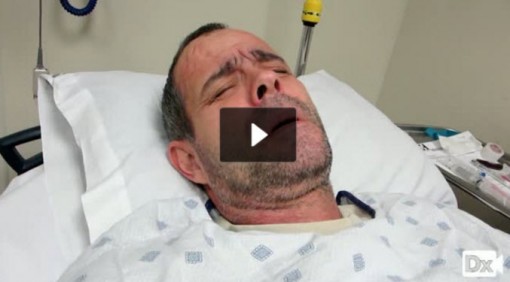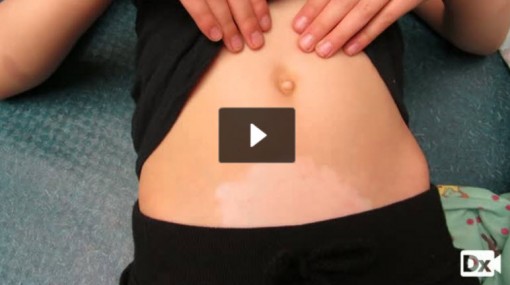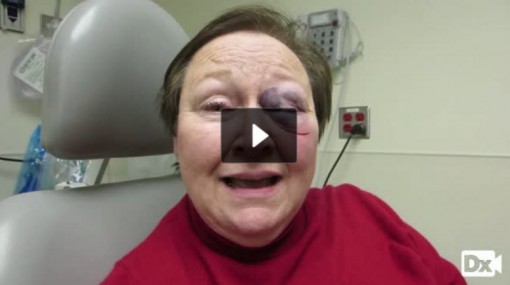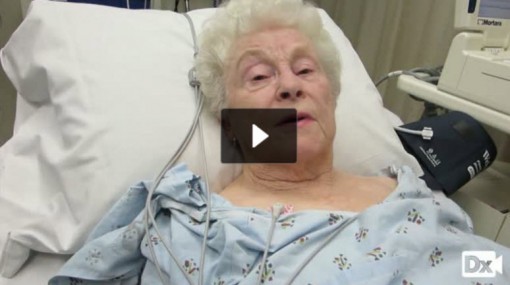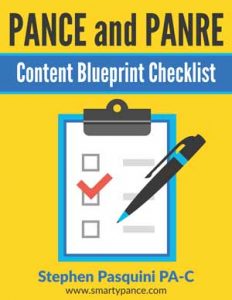Работайте офлайн с приложением Player FM !
Episode 51: The Audio PANCE and PANRE Board Review Podcast – Comprehensive Audio Quiz
Manage episode 182629340 series 97199
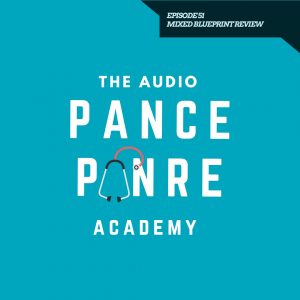 Welcome to episode 51 of the FREE Audio PANCE and PANRE Physician Assistant Board Review Podcast.
Welcome to episode 51 of the FREE Audio PANCE and PANRE Physician Assistant Board Review Podcast.
Join me as I cover ten PANCE and PANRE Board review questions from the Academy course content following the NCCPA content blueprint (download the FREE cheat sheet).
content blueprint (download the FREE cheat sheet).
This week we will be covering ten general board review questions based on the NCCPA PANCE and PANRE Content Blueprint.
Below you will find an interactive exam to complement the podcast.
I hope you enjoy this free audio component to the examination portion of this site. The full board review includes over 2,000 interactive board review questions and is available to all members of the PANCE and PANRE Academy and SmartyPANCE which are now bundled together into one very low price.
- You can download and listen to past FREE episodes here, on iTunes, on Google Play Music or Stitcher Radio.
- You can listen to the latest episode, take an interactive quiz and download your results below.
Listen Carefully Then Take The Quiz
If you can’t see the audio player click here to listen to the full episode.
Episode 51 PANCE and PANRE Podcast Quiz
The following 10 questions are linked to NCCPA Content Blueprint lessons from the SMARTYPANCE and PANRE Board review website. If you are a member you will be able to log in and view this interactive video content.
1. A 42-year-old male with a history of constipation presents with complaints of severe pain with defecation described as feeling like he is “tearing apart.” He has also noted occasional small amounts of blood on toilet paper. External examination of the rectum is unremarkable and an internal rectal exam cannot be performed due to severe pain when attempted. Which of the following is the most likely diagnosis?
A. Proctitis
B. Anal fissure
C. Rectal prolapse
D. Internal hemorrhoids
Anal fissures are covered as part of the NCCPA Content Blueprint GI and Nutrition which accounts for 10% of the exam
View this ReelDx patient video case of a 51-year-old with rectal bleeding and abdominal pain (proctitis)
Answer: B. Anal fissures
Anal fissures are easily diagnosed from history alone with the classic finding of severe pain upon defecation. Constipation is also a common cause of the trauma that leads to the development of a fissure.
A. Proctitis is usually caused by anorectal infections that produce symptoms of anorectal discomfort, tenesmus, constipation, and discharge from the rectum.
C. Rectal prolapse is commonly seen in elderly females with complaints that include an anal mass, rectal bleeding and a change in bowel habits.
D. While internal hemorrhoids may cause rectal bleeding, tearing pain is an uncommon complaint unless there is evidence of thrombosis of irreducible tissue.
2. What type of chest pain is most commonly associated with a dissecting aortic aneurysm?
A. Squeezing
B. Dull, aching
C. Ripping, tearing
D. Burning
Dissecting aortic aneurysm is covered as part of the NCCPA Cardiology Content Blueprint and accounts for 16% of the exam
Answer: C. A dissecting aortic aneurysm often presents with a very severe ripping, tearing like pain.
A dissecting aortic aneurysm often presents with a very severe ripping, tearing like pain.
A. Squeezing pain is more characteristic of angina or esophageal pain.
B. Dull, aching pain is more characteristic of chest wall pain, possibly angina, or anxiety.
D. Burning pain is more characteristic of esophageal reflux, esophagitis, or tracheobronchitis.
3. A 15-year-old softball player presents after jamming the distal tip of her finger into severe flexion. She is unable to extend the distal phalanx and she has pain on palpation of the distal interphalangeal joint. X-ray of the hand fails to reveal any associated avulsion fracture. Which of the following is the treatment of choice?
A. Open reduction and internal fixation
B. Continuous extension of the DIP with splinting
C. Continuous flexion of the PIP with splinting
D. Application of short arm cast
Soft tissue injuries of the forearm, wrist, and hand are covered as part of the NCCPA Musculoskeletal Content Blueprint and accounts for 10% of the exam
Answer: B. Continuous extension of the DIP with splinting
The treatment of choice for a tear in the extensor tendon of the finger is continuous extension of the DIP via splinting for 6 to 8 weeks.
D. Short arm casting is indicated in wrist and metacarpal injuries but not in DIP extensor injuries.
4. A patient presents with loss of pigmentation on the back of hands, face, and body folds due to the absence of epidermal melanocytes. There has been improvement with PUVA treatment. Which of the following is the most likely diagnosis?
A. Pityriasis alba
B. Tinea versicolor
C. Vitiligo
D. Melasma
View this ReelDx patient video case of a 7-year-old female with localized, depigmented skin patches; rash
Answer: C. Vitiligo
Vitiligo is the acquired loss of pigmentation due to the absence of epidermal melanocytes presenting on the back of hands, face, or body folds.
A. Pityriasis alba is caused by dermal inflammation that becomes scaly and hypopigmented.
B. Tinea versicolor is a fungal infection of the skin presenting as oval or circular lesions
D. Melasma is an acquired brown hyperpigmentation involving the face and neck in women during their second or third trimester of pregnancy.
5. Which of the following medications used in the management of anxiety has a delayed onset of action?
A. Buspirone (BuSpar)
B. Diphenhydramine (Benadryl)
C. Lorazepam (Ativan)
D. Butalbital (Fiorinal)
Anxiety disorders are covered as part of the NCCPA Content Psychiatry Blueprint which accounts for 6% of your exam
Answer: A. buspirone (BuSpar)
Buspirone takes several days to weeks for it to have clinical activity.
B. Diphenhydramine works as a histamine blocker and will cause sedation immediately because of its anticholinergic effects.
C. Lorazepam is an anxiolytic medication that has an immediate onset of activity.
D. Butalbital is a short to intermediate-acting barbiturate that has immediate activity.
6. A 57-year-old male was working on his farm when some manure was slung hitting his left eye. He presents several days after with a red, tearing, painful eye. Fluorescein stain reveals uptake over the cornea looking like a shallow crater. Which of the following interventions would be harmful?
A. Ophthalmic antibiotics
B. Pressure patch
C. Examination for visual acuity
D. Copious irrigation
Corneal abrasion is covered as part of the NCCPA EENT Content Blueprint and accounts for 9% of the exam
Answer: B. Pressure patch
Patching of the eye after a corneal abrasion associated with organic material contamination is contraindicated due to increased risk of fungal infection.
A. Ophthalmic antibiotics and copious irrigation are indicated when treating a patient with a suspected corneal ulcer due to an infectious cause.
C. Examination for assessment of visual acuity should be performed.
7. A 75-year-old female falls on her outstretched arm. She sustains a humeral mid-shaft fracture. Nerve impingement occurs due to the fracture. What is the most likely physical examination abnormality that will be encountered?
A. Inability to extend the wrist against resistance
B. Numbness over the deltoid muscle in the shoulder
C. Winging of the scapula
D. Weakness of the rotator cuff
Fractures and dislocations of the forearm, wrist, and hand are covered as part of the NCCPA Musculoskeletal Content Blueprint and accounts for 10% of the exam
Answer: D. Inability to extend the wrist against resistance
The radial nerve is most likely entrapped by this fracture. Radial nerve damage will cause an inability to extend the wrist against resistance.
B. Axillary nerve injury results in numbness over the deltoid muscle; this nerve is more commonly injured in proximal humeral fractures and anterior shoulder dislocations.
C. Injury to the long thoracic nerve causes winging of the scapula due to its innervation of the serratus anterior muscle.
D. Injury to the subscapular nerve results in weakness and pain of the infraspinatus muscle; this injury is commonly seen in volleyball players from repetitive stress.
8. A 16-year-old male involved in a fight sustained a laceration to his right upper eyelid. He is unable to open his eye, and a possible laceration of the globe is suspected. Which of the following is the next step?
A. Use a slit lamp to determine the extent of the injury.
B. Use fluorescein strips to determine the extent of the injury.
C. Apply a metal eye shield and refer to an ophthalmologist.
D. Apply antibiotic ointment to the lid and recheck in 24 hours.
Disorders of they eye are covered as part of the NCCPA EENT Content Blueprint and accounts for 9% of the exam
66-year-old female with acute onset of periorbital deformity. SmartyPANCE ReelDx + members can view this real-world case!
Answer: C. Apply a metal eye shield and refer to an ophthalmologist.
Protect the eye from any pressure with a rigid metal eye shield and refer for immediate ophthalmologic consultation. Avoid unnecessary actions that would delay treatment or cause further injury.
9. Which of the following typical findings would be revealed during a sigmoidoscopy on a patient with Crohn’s disease of the intestine?
A. Rectal pseudopolyps
B. Diffuse ulceration and bleeding
C. Sheets of WBCs with inflamed mucosa
D. Intermittent longitudinal mucosal ulcers and fissures
Inflammatory bowel disease is covered as part of the NCCPA Content Blueprint GI and Nutrition which accounts for 10% of the exam
Answer: D. Intermittent longitudinal mucosal ulcers and fissures
Ulcerations tend to be linear with transverse fissures in Crohn’s disease. These skip lesions are common with Crohn’s disease.
A. Rectal pseudopolyps are associated with ulcerative colitis rather than Crohn’s.
B. Diffuse ulcerations and bleeding are more characteristic of ulcerative colitis than Crohn’s disease.
C. Sheets of WBCs or “pseudomembranes” can be detected in patients with pseudomembranous colitis.
10. A 72-year-old patient with a history of hypertension and atrial fibrillation presents with episodes of weakness, numbness, and paresthesia’s in the right arm. At the same time, she notes speech difficulty and loss of vision in her left eye. These symptoms come on abruptly and clear within minutes. Physical examination is normal except for the previously known arrhythmia. Which of the following is the most likely diagnosis?
A. Focal seizure
B. Migraine headache
C. Hypoglycemic episodes
D. Transient ischemic attack
Atrial fibrillation is covered as part of the NCCPA Cardiology Content Blueprint which is 16% of your exam
SmartyPANCE + ReelDx members can view this ReelDx patient case video of an 83-year-old with fast heart rate, palpitations
Answer: D. Transient ischemic attack
This patient’s symptoms are consistent with transient ischemia in the carotid territory. Atrial fibrillation is a risk factor for cerebral emboli.
A. Focal seizures usually cause abnormal motor movement rather than weakness or loss of feeling.
B. Patients with migraines commonly have a history of episodes since adolescence.
C. Hypoglycemic episodes do not present with focal neurological findings.
Looking for all the podcast episodes?
This FREE series is limited to every other episode, you can download and enjoy the complete audio series by joining The PANCE and PANRE Exam Academy + SMARTYPANCE
I will be releasing new episodes every few weeks. The Academy is discounted, so sign up now.
Resources and Links From The Show
- Join the PANCE and PANRE Academy + Smarty PANCE
- My list of recommended PANCE and PANRE review books
- Download the FREE PANCE and PANRE Blueprint Checklist
- Sign up for the FREE daily PANCE and PANRE email series
- The Smarty PANCE NCCPA Content Blueprint Website + The PA Life Academy
- USE CODE “PALIFE” TO GET 10% OFF THE RUTGERS PANCE AND PANRE REVIEW COURSE
This Podcast is also available on iTunes and Stitcher Radio for Android
- iTunes: The Audio PANCE AND PANRE Podcast iTunes
- Stitcher Radio: The Audio PANCE and PANRE Podcast Stitcher
Download The Content Blueprint Checklist
Follow this link to download your FREE copy of the Content Blueprint Checklist
Print it up and start crossing out the topics you understand, marking the ones you don’t and making notes of key terms you should remember. The PDF version is interactive and linked directly to the individual lessons on SMARTY PANCE.
The post Episode 51: The Audio PANCE and PANRE Board Review Podcast – Comprehensive Audio Quiz appeared first on The Audio PANCE and PANRE.
68 эпизодов
Episode 51: The Audio PANCE and PANRE Board Review Podcast – Comprehensive Audio Quiz
The Audio PANCE and PANRE Physician Assistant Board Review Podcast
Manage episode 182629340 series 97199
 Welcome to episode 51 of the FREE Audio PANCE and PANRE Physician Assistant Board Review Podcast.
Welcome to episode 51 of the FREE Audio PANCE and PANRE Physician Assistant Board Review Podcast.
Join me as I cover ten PANCE and PANRE Board review questions from the Academy course content following the NCCPA content blueprint (download the FREE cheat sheet).
content blueprint (download the FREE cheat sheet).
This week we will be covering ten general board review questions based on the NCCPA PANCE and PANRE Content Blueprint.
Below you will find an interactive exam to complement the podcast.
I hope you enjoy this free audio component to the examination portion of this site. The full board review includes over 2,000 interactive board review questions and is available to all members of the PANCE and PANRE Academy and SmartyPANCE which are now bundled together into one very low price.
- You can download and listen to past FREE episodes here, on iTunes, on Google Play Music or Stitcher Radio.
- You can listen to the latest episode, take an interactive quiz and download your results below.
Listen Carefully Then Take The Quiz
If you can’t see the audio player click here to listen to the full episode.
Episode 51 PANCE and PANRE Podcast Quiz
The following 10 questions are linked to NCCPA Content Blueprint lessons from the SMARTYPANCE and PANRE Board review website. If you are a member you will be able to log in and view this interactive video content.
1. A 42-year-old male with a history of constipation presents with complaints of severe pain with defecation described as feeling like he is “tearing apart.” He has also noted occasional small amounts of blood on toilet paper. External examination of the rectum is unremarkable and an internal rectal exam cannot be performed due to severe pain when attempted. Which of the following is the most likely diagnosis?
A. Proctitis
B. Anal fissure
C. Rectal prolapse
D. Internal hemorrhoids
Anal fissures are covered as part of the NCCPA Content Blueprint GI and Nutrition which accounts for 10% of the exam
View this ReelDx patient video case of a 51-year-old with rectal bleeding and abdominal pain (proctitis)
Answer: B. Anal fissures
Anal fissures are easily diagnosed from history alone with the classic finding of severe pain upon defecation. Constipation is also a common cause of the trauma that leads to the development of a fissure.
A. Proctitis is usually caused by anorectal infections that produce symptoms of anorectal discomfort, tenesmus, constipation, and discharge from the rectum.
C. Rectal prolapse is commonly seen in elderly females with complaints that include an anal mass, rectal bleeding and a change in bowel habits.
D. While internal hemorrhoids may cause rectal bleeding, tearing pain is an uncommon complaint unless there is evidence of thrombosis of irreducible tissue.
2. What type of chest pain is most commonly associated with a dissecting aortic aneurysm?
A. Squeezing
B. Dull, aching
C. Ripping, tearing
D. Burning
Dissecting aortic aneurysm is covered as part of the NCCPA Cardiology Content Blueprint and accounts for 16% of the exam
Answer: C. A dissecting aortic aneurysm often presents with a very severe ripping, tearing like pain.
A dissecting aortic aneurysm often presents with a very severe ripping, tearing like pain.
A. Squeezing pain is more characteristic of angina or esophageal pain.
B. Dull, aching pain is more characteristic of chest wall pain, possibly angina, or anxiety.
D. Burning pain is more characteristic of esophageal reflux, esophagitis, or tracheobronchitis.
3. A 15-year-old softball player presents after jamming the distal tip of her finger into severe flexion. She is unable to extend the distal phalanx and she has pain on palpation of the distal interphalangeal joint. X-ray of the hand fails to reveal any associated avulsion fracture. Which of the following is the treatment of choice?
A. Open reduction and internal fixation
B. Continuous extension of the DIP with splinting
C. Continuous flexion of the PIP with splinting
D. Application of short arm cast
Soft tissue injuries of the forearm, wrist, and hand are covered as part of the NCCPA Musculoskeletal Content Blueprint and accounts for 10% of the exam
Answer: B. Continuous extension of the DIP with splinting
The treatment of choice for a tear in the extensor tendon of the finger is continuous extension of the DIP via splinting for 6 to 8 weeks.
D. Short arm casting is indicated in wrist and metacarpal injuries but not in DIP extensor injuries.
4. A patient presents with loss of pigmentation on the back of hands, face, and body folds due to the absence of epidermal melanocytes. There has been improvement with PUVA treatment. Which of the following is the most likely diagnosis?
A. Pityriasis alba
B. Tinea versicolor
C. Vitiligo
D. Melasma
View this ReelDx patient video case of a 7-year-old female with localized, depigmented skin patches; rash
Answer: C. Vitiligo
Vitiligo is the acquired loss of pigmentation due to the absence of epidermal melanocytes presenting on the back of hands, face, or body folds.
A. Pityriasis alba is caused by dermal inflammation that becomes scaly and hypopigmented.
B. Tinea versicolor is a fungal infection of the skin presenting as oval or circular lesions
D. Melasma is an acquired brown hyperpigmentation involving the face and neck in women during their second or third trimester of pregnancy.
5. Which of the following medications used in the management of anxiety has a delayed onset of action?
A. Buspirone (BuSpar)
B. Diphenhydramine (Benadryl)
C. Lorazepam (Ativan)
D. Butalbital (Fiorinal)
Anxiety disorders are covered as part of the NCCPA Content Psychiatry Blueprint which accounts for 6% of your exam
Answer: A. buspirone (BuSpar)
Buspirone takes several days to weeks for it to have clinical activity.
B. Diphenhydramine works as a histamine blocker and will cause sedation immediately because of its anticholinergic effects.
C. Lorazepam is an anxiolytic medication that has an immediate onset of activity.
D. Butalbital is a short to intermediate-acting barbiturate that has immediate activity.
6. A 57-year-old male was working on his farm when some manure was slung hitting his left eye. He presents several days after with a red, tearing, painful eye. Fluorescein stain reveals uptake over the cornea looking like a shallow crater. Which of the following interventions would be harmful?
A. Ophthalmic antibiotics
B. Pressure patch
C. Examination for visual acuity
D. Copious irrigation
Corneal abrasion is covered as part of the NCCPA EENT Content Blueprint and accounts for 9% of the exam
Answer: B. Pressure patch
Patching of the eye after a corneal abrasion associated with organic material contamination is contraindicated due to increased risk of fungal infection.
A. Ophthalmic antibiotics and copious irrigation are indicated when treating a patient with a suspected corneal ulcer due to an infectious cause.
C. Examination for assessment of visual acuity should be performed.
7. A 75-year-old female falls on her outstretched arm. She sustains a humeral mid-shaft fracture. Nerve impingement occurs due to the fracture. What is the most likely physical examination abnormality that will be encountered?
A. Inability to extend the wrist against resistance
B. Numbness over the deltoid muscle in the shoulder
C. Winging of the scapula
D. Weakness of the rotator cuff
Fractures and dislocations of the forearm, wrist, and hand are covered as part of the NCCPA Musculoskeletal Content Blueprint and accounts for 10% of the exam
Answer: D. Inability to extend the wrist against resistance
The radial nerve is most likely entrapped by this fracture. Radial nerve damage will cause an inability to extend the wrist against resistance.
B. Axillary nerve injury results in numbness over the deltoid muscle; this nerve is more commonly injured in proximal humeral fractures and anterior shoulder dislocations.
C. Injury to the long thoracic nerve causes winging of the scapula due to its innervation of the serratus anterior muscle.
D. Injury to the subscapular nerve results in weakness and pain of the infraspinatus muscle; this injury is commonly seen in volleyball players from repetitive stress.
8. A 16-year-old male involved in a fight sustained a laceration to his right upper eyelid. He is unable to open his eye, and a possible laceration of the globe is suspected. Which of the following is the next step?
A. Use a slit lamp to determine the extent of the injury.
B. Use fluorescein strips to determine the extent of the injury.
C. Apply a metal eye shield and refer to an ophthalmologist.
D. Apply antibiotic ointment to the lid and recheck in 24 hours.
Disorders of they eye are covered as part of the NCCPA EENT Content Blueprint and accounts for 9% of the exam
66-year-old female with acute onset of periorbital deformity. SmartyPANCE ReelDx + members can view this real-world case!
Answer: C. Apply a metal eye shield and refer to an ophthalmologist.
Protect the eye from any pressure with a rigid metal eye shield and refer for immediate ophthalmologic consultation. Avoid unnecessary actions that would delay treatment or cause further injury.
9. Which of the following typical findings would be revealed during a sigmoidoscopy on a patient with Crohn’s disease of the intestine?
A. Rectal pseudopolyps
B. Diffuse ulceration and bleeding
C. Sheets of WBCs with inflamed mucosa
D. Intermittent longitudinal mucosal ulcers and fissures
Inflammatory bowel disease is covered as part of the NCCPA Content Blueprint GI and Nutrition which accounts for 10% of the exam
Answer: D. Intermittent longitudinal mucosal ulcers and fissures
Ulcerations tend to be linear with transverse fissures in Crohn’s disease. These skip lesions are common with Crohn’s disease.
A. Rectal pseudopolyps are associated with ulcerative colitis rather than Crohn’s.
B. Diffuse ulcerations and bleeding are more characteristic of ulcerative colitis than Crohn’s disease.
C. Sheets of WBCs or “pseudomembranes” can be detected in patients with pseudomembranous colitis.
10. A 72-year-old patient with a history of hypertension and atrial fibrillation presents with episodes of weakness, numbness, and paresthesia’s in the right arm. At the same time, she notes speech difficulty and loss of vision in her left eye. These symptoms come on abruptly and clear within minutes. Physical examination is normal except for the previously known arrhythmia. Which of the following is the most likely diagnosis?
A. Focal seizure
B. Migraine headache
C. Hypoglycemic episodes
D. Transient ischemic attack
Atrial fibrillation is covered as part of the NCCPA Cardiology Content Blueprint which is 16% of your exam
SmartyPANCE + ReelDx members can view this ReelDx patient case video of an 83-year-old with fast heart rate, palpitations
Answer: D. Transient ischemic attack
This patient’s symptoms are consistent with transient ischemia in the carotid territory. Atrial fibrillation is a risk factor for cerebral emboli.
A. Focal seizures usually cause abnormal motor movement rather than weakness or loss of feeling.
B. Patients with migraines commonly have a history of episodes since adolescence.
C. Hypoglycemic episodes do not present with focal neurological findings.
Looking for all the podcast episodes?
This FREE series is limited to every other episode, you can download and enjoy the complete audio series by joining The PANCE and PANRE Exam Academy + SMARTYPANCE
I will be releasing new episodes every few weeks. The Academy is discounted, so sign up now.
Resources and Links From The Show
- Join the PANCE and PANRE Academy + Smarty PANCE
- My list of recommended PANCE and PANRE review books
- Download the FREE PANCE and PANRE Blueprint Checklist
- Sign up for the FREE daily PANCE and PANRE email series
- The Smarty PANCE NCCPA Content Blueprint Website + The PA Life Academy
- USE CODE “PALIFE” TO GET 10% OFF THE RUTGERS PANCE AND PANRE REVIEW COURSE
This Podcast is also available on iTunes and Stitcher Radio for Android
- iTunes: The Audio PANCE AND PANRE Podcast iTunes
- Stitcher Radio: The Audio PANCE and PANRE Podcast Stitcher
Download The Content Blueprint Checklist
Follow this link to download your FREE copy of the Content Blueprint Checklist
Print it up and start crossing out the topics you understand, marking the ones you don’t and making notes of key terms you should remember. The PDF version is interactive and linked directly to the individual lessons on SMARTY PANCE.
The post Episode 51: The Audio PANCE and PANRE Board Review Podcast – Comprehensive Audio Quiz appeared first on The Audio PANCE and PANRE.
68 эпизодов
모든 에피소드
×Добро пожаловать в Player FM!
Player FM сканирует Интернет в поисках высококачественных подкастов, чтобы вы могли наслаждаться ими прямо сейчас. Это лучшее приложение для подкастов, которое работает на Android, iPhone и веб-странице. Зарегистрируйтесь, чтобы синхронизировать подписки на разных устройствах.
